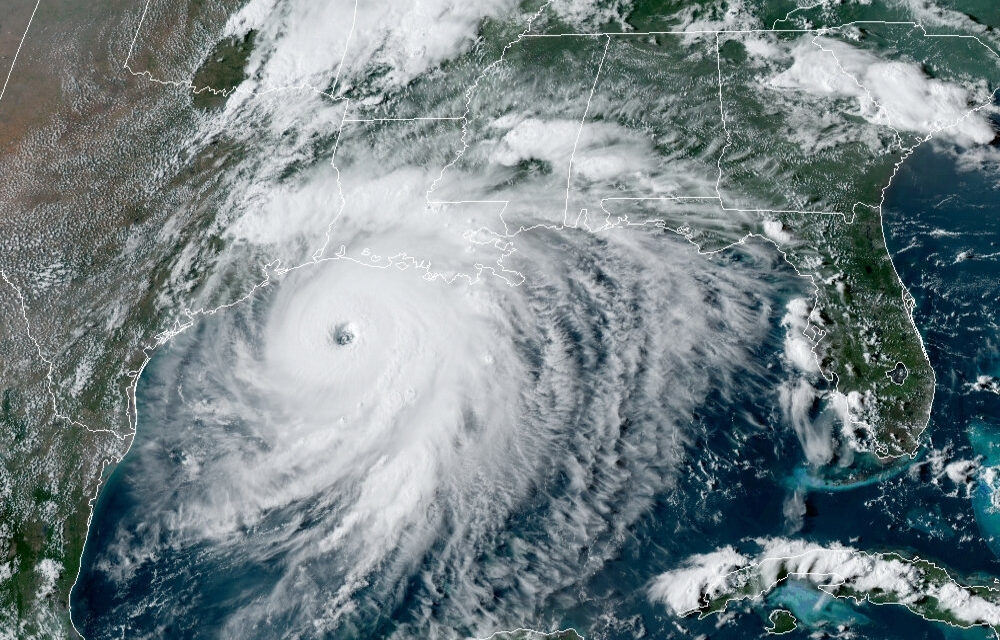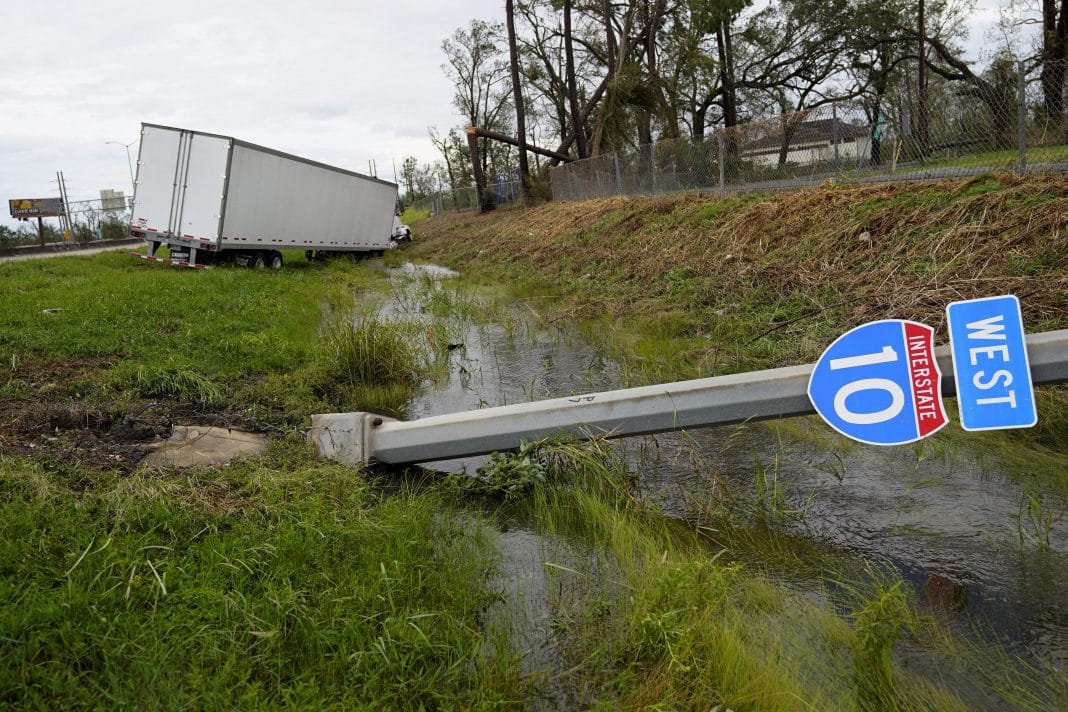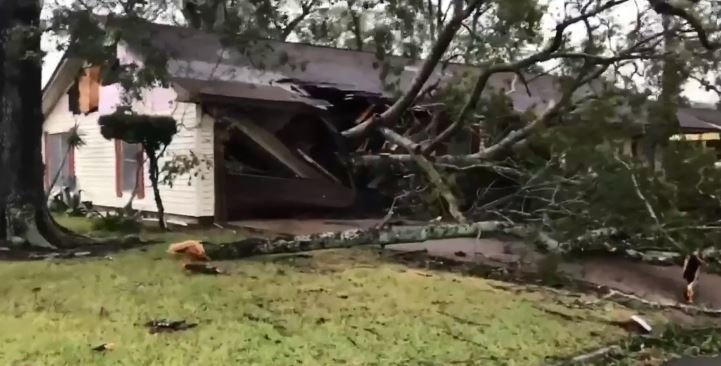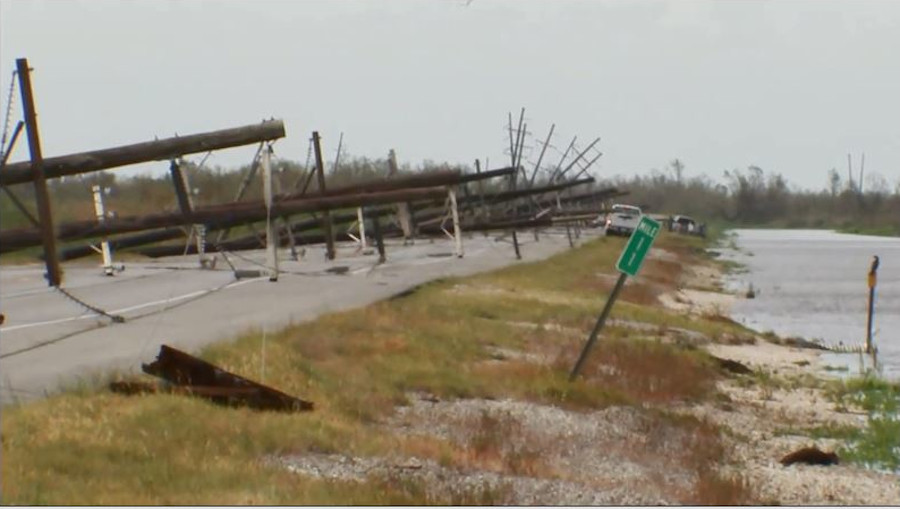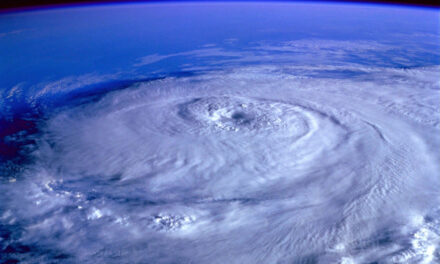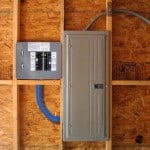Hurricane Laura over the Gulf of Mexico on August 26, 2020. Note the distinctive eye and well defined bands or arms. A Category 4 Hurricane with 150 MPH Winds.
Homes and Businesses Devastated by the Powerful Category 4 Storm
Major Hurricane Laura made landfall about 2 AM near Cameron Louisiana, about 15 miles east of the Texas-Louisiana state line. Hours before the storm arrived, newscasters documented the rising winds and flood waters. Laura is the twelfth named storm, the thirteenth tropical cyclone, and the first Major Hurricane of the 2020 Atlantic Hurricane Season. While much of the news media focused on Lake Charles, LA the damage was just as bad or worse in other areas.
More than 2 million people are without power this morning after Laura devastated local power grids. Widespread Power Outages will spread north and east as Laura, now a tropical storm over Arkansas, moves into Tennessee and Kentucky. Laura was still a hurricane with 75 MPH winds when it crossed the Louisiana-Arkansas border. Utility companies expect full recovery to take weeks.
How to Prepare for a Power Outage
Laura began as a depression in the central tropical Atlantic Ocean. It traveled the full length of the Caribbean Islands as a tropical storm before it crossed the Florida Keys into the Gulf of Mexico. In the Gulf, it grew into a hurricane and then quickly intensified to category 4 just hours before it made landfall in Louisiana with 150 MPH winds—nearly category 5.
We were staying until it hit Category 3. , Rita wasn’t so bad, but that was only 115 mile winds. They’re saying the water might be unsurvivable. Like 15 feet deep. So we’re battening down the hatches and getting out before they close us down. Dallas probably. Hopefully we have something left when we come back.
????Laura's impressive structure continues to improve by the minute as this GOES satellite loop of the last 30 minutes shows. While Laura will remain well west of our area this is a life threatening situation to areas along the southwestern Louisiana Coast and Eastern Texas coast. pic.twitter.com/06D6warOOC
— NWS Mobile (@NWSMobile) August 26, 2020
Last Minute Evacuations Hampered by Floods–COVID-19
A Road Sign Blown Over and a Semi Truck in a flooded ditch on Interstate 10. The highway closed at 9:00 PM from the Texas-Louisiana Border East to the Atchafalaya Basin.
Mandatory evacuation orders were issued for many communities and areas, but COVID-19 Social Distancing Rules hampered efforts evacuate and shelter residents. A pair of C130 planes sent to Port Arthur, Texas in a last-ditch evacuation effort, could only hold 40 passengers each due to COVID-19 guidelines. A C130 normally carries up to 92 passengers plus crew.
Residents who stayed through Hurricane Rita believed they could ride out Laura. Rita had 115 MPH winds when it made landfall in September 2005. However, as Laura drew closer and grew stronger, warnings of a “unsurvivable” storm surge prompted many in low-lying areas to leave. The National Hurricane Center warned of a storm-surge up to 15 feet.
Make a Hurricane Evacuation Plan
Evacuating became more difficult as the storm approached. Those who waited found shelters closed due to COVID-19 distancing rules. Many had run out of hotel vouchers and simply turned people away. Buses took people to Dallas and other cities.
Interstate Highway 10, about thirty miles north of the coast, closed at 9 PM from the Louisiana-Texas state line to the Atchafalaya Basin in Louisiana and forced last-minute evacuees to detour.
In what may have been an unprecedented move, the National Weather Service evacuated its Lake Charles, LA station. The NEXRAD radar dome and tower was destroyed at landfall. Operations were moved to Brownsville, Texas.
While I-10 in Texas remains open, please check https://t.co/lqEHtsNc0v for the most current road closures prior to traveling. Be patient and drive safely. #TXWX #Laura #HurricaneLaura https://t.co/QfuEvkeqbs
— TxDOT (@TxDOT) August 27, 2020
Devastating Damage
A tree fell into a home, snapped off during Hurricane Laura, in Texas near the Louisiana Border. To date, most deaths attributed to Hurricane Laura in the United States were caused by falling trees.
Laura’s left a swath of devastation across southwest Louisiana and southwest Texas. Utility poles snapped in half. Unsurpassable roads covered with utility lines and poles, downed trees, and debris. Collapsed store fronts. Shredded buildings. Roofs ripped to pieces or missing entirely. Hotels sitting in water.
At least 30 people in the USA and across the Caribbean have died in the hurricane or tropical storm.
High rise buildings with half the wind-facing windows shattered. A 14-year-old girl in Louisiana died when a tree fell on her family home.
10 Tips to Survive a Hurricane Disaster
Some homes flooded. Others reduced to rubble or a foundation. A few standing walls surrounded by splinters.
Submerged roadways disappeared with flooded homes and businesses on either side. The strength of the storm kept storm surge waters in place while heavy rains added to the flooding and flash flooding. Although the worst-case surge scenario did not materialize, it was bad enough to leave extensive damage throughout the area. Large areas remain under water.
As Texas and Louisiana survey the damage and residents hope to return, yet another tropical wave has left the African Coast. With up to 13 more named stormed expected in the next two months, forecasters are already looking ahead to the next tropical cyclone.
How to Use a Portable Generator for Emergency Power
Portable Generator Safety Rules to Live By
Laura has not yet dissipated. Tennessee and Kentucky are the next states on the way to the East Coast where, once again, Laura may strengthen and bode ill for anything in her path.
Look at my city #lakecharleslouisiana this crazy!!! #HurricaneLaura2020 pic.twitter.com/0MN5DWjfdY
— #PrayersforLouisiana (@kidcharmaine) August 27, 2020
A chemical plant is leaking outside of Lake Charles, Louisiana. #HurricaneLaura2020 #LakeCharlesLouisiana pic.twitter.com/x3qglmqA5s
— IFN News (@IFNewsTV) August 27, 2020
A Road Entirely Blocked by Downed Utility Poles and Power Lines in the Aftermath of Hurricane Laura

